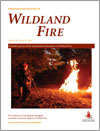International Journal of Wildland Fire
Volume 25
Number 9 2016
A traditional fire knowledge system exists in the Monarch Butterfly Biosphere Reserve in Mexico that is transmitted orally and through practice. It includes nine types of fire uses for agriculture, animal husbandry and forestry activities. We recommend that this knowledge should be incorporated into an integrated fire management plan.
Studies about fire regimes in grasslands are lacking. We describe the recent fire regime of north-western Patagonian grasslands using remote sensed data combined with fire statistics from an operational database. Our results contribute to general knowledge about fire in grasslands and provide useful information for sustainable management of these ecosystems.
To better understand post-fire recovery of big sagebrush ecosystems, we sampled and analysed data collected in and near 16 fires that burned between 5 and 28 years ago. Our results indicate that big sagebrush recovery is a highly variable but generally slow process that may require several decades on average.
This is the first study conducted on the effect of prescribed burning on the soil seed bank in a subtropical pine–oak forest. Our results show that the soil seed bank can promote revegetation, persistence and diversity of the pine–oak understorey vegetation following fire.
We use the Maximum Entropy method (MaxEnt) to model the probability of fire occurrence in the Brazilian Amazon during the 2008 and 2010 fire seasons and we conclude that MaxEnt may become an important tool to guide firefighting and fire-prevention programs to minimise forest degradation and carbon loss from fires in the Amazon.
How a fire develops into a certain shape is still an open area of research. We provide a method to mathematically describe the growth of a fire perimeter and use this method to produce shapes described in the literature and matched to experimental fires. The method could be used for flexible fire shape templates in computational systems or to build two-dimensional rate of spread models for fire prediction.
Prescribed burning in chaparral occurs under marginal burning conditions that are often difficult to predict. This paper compares the ability of several models to predict fire spread success and fire rate of spread with observed rate of spread from laboratory fires in fuel beds composed of only live chaparral shrubs.
We evaluated the predictive capacity of dead fuel moisture models for grassland fuels in Australia. We identified the most accurate models and the error associated with them. Results have direct operational application for fire behaviour prediction and fire danger rating, and to determine public warning levels.
Through laboratory-scale burning experiments, we determined that fire intensity in masticated fuels declines with fuelbed age and older fuels smoulder for a longer duration.
This study quantifies the impact of canopy cover interception on estimates of fire radiative power via a laboratory experiment. Samples included both desiccated and non-transpiring living branches assessed over a range of canopy covers. Results characterise the rate of attenuation of fire radiative power with canopy cover.




